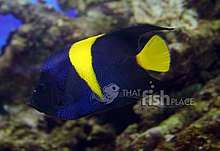Pomacanthus asfur
Pomacanthus asfur, the Arabian angelfish, is a fish well known for its use in saltwater aquariums, even though it tends to be a shyer specimen compared to the other, sometimes aggressive, angelfish.[1][2]
| Arabian angelfish | |
|---|---|
 | |
| Scientific classification | |
| Kingdom: | Animalia |
| Phylum: | Chordata |
| Class: | Actinopterygii |
| Order: | Perciformes |
| Family: | Pomacanthidae |
| Genus: | Pomacanthus |
| Species: | P. asfur |
| Binomial name | |
| Pomacanthus asfur (Forsskål, 1775) | |
Description
The Arabian angelfish grows to a maximum length of 40 centimetres (16 in). The adult is generally dark greyish-black with a broad, crescent-shaped sash of yellow and a yellow tail. The dorsal fin has 12 spines and 19–20 soft rays and is elongated into filaments which trail behind the fish as it swims. The anal fin is also extended by filaments and has 3 spines and 18 to 20 soft rays. The pectoral fins have 17 to 18 rays. The juveniles have an altogether different appearance. They have a base colour of steely blue with a number of vertical, meandering stripes of white and pale blue.[3]
Distribution and habitat
The Arabian angelfish is found along the eastern coasts of Africa at depths up to 15 metres (49 ft). Its range extends from the Red Sea and the Gulf of Aden to Zanzibar. It can be found also in the Persian Gulf. There are unconfirmed sightings of this species off the coast of Florida.[3] Its habitat includes sheltered coastal reefs with hard and soft corals, rocky reefs, crevices and the mouths of caves. It is timid which makes it difficult to observe.[3]
Biology
The Arabian angelfish feeds predominately on tunicates and sponges. The eggs are laid singly on the seabed.
References
- "Arabian Angelfish (Animal-World Pet and Animal Information)". Retrieved 15 September 2008.
- "Asfur Angelfish (Pet Education)". Retrieved 15 September 2008.
- Pomacanthus asfur, Forsskål 1775: Arabian angelfish Retrieved 27 February 2012.
| Wikispecies has information related to Pomacanthus asfur |
